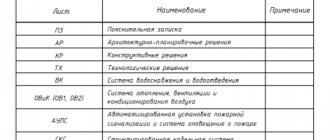Definition of the concept
Residential premises are separate premises related to real estate and intended for continuous residence of people. Must meet developed hygienic, industrial standards (Article 15 of the Housing Code). To characterize a living space, it is necessary to highlight the common and living area:
- total - the sum of the area of all parts of residential premises except balconies and verandas;
- living room - part of the common one, including living rooms.
The process of declaring a premises residential, the requirements for residential premises are developed by government authorities.
What does the law say?
Usually, to decipher a particular significant concept, it is most reliable and easiest to resort to the help of current legislation: how it is interpreted there is how it should be understood .
But the whole point is that it is not defined in any way in the laws, moreover, it is not even mentioned practically anywhere. There is room, but no space .
The only exception is the law regulating the social protection of the rights of people with disabilities in Russia. But there, these words mean the premises as a whole, that is, an apartment, a private house or a room - everything classified by law in this category.
Watch the video: Technical passport of residential premises, types and functions
But, as the practice of using this term shows, we are usually not talking about the property as a whole, but about a certain part of it. So the question arises: what is included in the living area of the apartment and what to do with the remaining parts - are they really non-residential? But from the point of view of current legislation, the entire premises as a whole are residential. So go figure out what actually belongs to the living space, what is customary to include in it.
There is usually no data on living space in official documents for an apartment . Let's imagine the situation. You put your home up for sale, buyers started calling, asking what the living space is, and what should you tell them? And where does this information come from in other similar advertisements or descriptions of apartments on developer websites? In general, go there, I don’t know where, bring something, I don’t know what.
Separateness
Residential premises (hereinafter referred to as residential premises) are combined according to a number of parameters. The first is separation: one housing estate must dissociate itself from its neighbor. An isolated object can be represented as a building or part of it. Moreover, its parameters should make it possible to differentiate from other objects.
According to the regulations, an apartment room that is not delimited from another space is not included in this group. It is considered a single part with other areas of a particular property. It cannot be purchased or alienated separately.
Terminology difficulties
This very combination of words is familiar to many who lived through Soviet times. If you strain your memory a little more, it will come to mind that the apartment has two areas:
- residential,
- general.
But everything is clear with it: that’s why it’s common because it includes absolutely all the rooms in the apartment. Here difficulties can arise only when it comes to some foreign countries, for example, Bulgaria.
In the latter, it is customary to include a slightly larger apartment in the square footage than is practiced in Russia. If at home this does not include loggias, balconies and the area of the staircase adjacent to the front door, then the Bulgarians generously include all of the above. So it turns out: an apartment of 50 square meters with a balcony here and in Bulgaria are not exactly the same.
To understand how many “squares” there will be, by our standards, in such a Bulgarian apartment, you will have to subtract the square footage of the balcony from 50. In our country, if you count in Bulgarian, you will need to add it to the given figure. This difference in calculation approaches even received the humorous name “Bulgarian meter”.
It’s easiest when it comes to a dorm room or communal apartment. In advertisements for the sale of such objects, only one value is indicated - that’s all. And everyone understands what we are talking about. But with an apartment or private house you have to solve a riddle.
By the way, some confusion in understanding is also associated with the traditions of Soviet times. Back then, “living space” also meant an apartment, room or private house. And this very living space, with the exception of the room, had two areas - common and residential. This is what “oil oil” is like.
Habitability
When developing the requirements that apply to an object, they resort to the provisions of government authority - Order No. 522. A premises that is in a dilapidated state or has visible grounds that negatively affect the object is considered unfit.
The classification of housing as unfit is carried out by an interdepartmental committee created by the regional executive power. The state body has the right to form brigades operating within the same city department. The responsibilities of the working group include checking residential premises and their characteristics.
Residential vs non-residential: the next step
A little less than a month ago, I read a post about how they want to ban the construction of apartments in Russia. At first I thought: well, another ban, there have been so many of them already. But after some time, this sentence stuck together in my head with some other stories of recent years and forced me to make certain generalizations. After all, apartments are classified as non-residential premises, so why ban them? The treasury is a net benefit: benefits for utility bills do not apply to them, more money can be collected, which means that contributions to the budget also increase. However, they are prohibited... Is it really because in non-residential premises you can choose the purpose of individual parts and use them as you please, like there is too much freedom, while residential premises should be used for the residence of citizens and nothing else!
And then I remembered another action that had already taken place in recent years - the de facto ban on using apartments located in apartment buildings as mini-hotels (I’m omitting the details). After all, hotels are also non-residential premises, although it is not clear why, since they are precisely used for the residence of citizens. It just happened historically that they do not belong to the housing stock, although hostels identical to them do. In Soviet times, the systematic rental of apartments was, at a minimum, not welcomed, and even punishable. Whether the ban on mini-hotels helps replenish the treasury or not is not easy to determine. On the one hand, utilities are provided to them at “preferential” prices, on the other, the systematic rental of premises, as a rule, required appropriate registration and payment of taxes, which the budget loses.
And even earlier, numerous conflicts broke out between the owners and residents of apartments in apartment buildings and restaurants located in the same buildings, which are noisy and open at night, preventing people from sleeping (on Patriki in Moscow, on Rubinshteina in St. Petersburg). The authorities in these conflicts, as a rule, sided with the residents, restricting restaurateurs or completely prohibiting them from operating. The goal was declared to be good - to protect the interests of citizens living in apartment buildings, albeit at the expense of the budget, which was deprived of tax revenues. I’m not sure, however, that the income will be large, because everyone knows how difficult it is to force restaurateurs to pay taxes in full.
It would seem that all three situations can serve as beautiful examples of how state (municipal) bodies and their officials take care of the interests of citizens. Only citizens are unlikely to believe this. Improving the quality of service to the housing stock and reducing fees for housing and utilities would contribute much more to the growth of citizens’ well-being. This is where the maximum effort would have to be made. However, prices in the housing sector are steadily rising, and quality is declining. Ask what the average citizen would choose: expel the restaurant from the first floor of the house or reduce housing payments by two or three times. I think that the majority will be in favor of reducing payments. This means that it is not a matter of caring for the interests of citizens, but something else. What?
I see only one reason here: the manic desire of state (municipal) bodies to limit the freedom of citizens and organizations to use their property. What are apartments? Non-residential premises for free use! Ban! Mini-hotels are also a way to break out of the strict restrictions imposed on residential premises, while increasing income. It is forbidden! The use of premises for restaurants and entertainment venues, subject to the established restrictions, seems to be legal. Organize regular inspections, depriving you of income! Do you want to change the purpose of the premises? But here is an order that cannot be overcome! I won’t even remember about the coronavirus...
We must not forget that the bureaucratic apparatus and citizens with independent sources of income are historical enemies. During periods when the freedom of society is under threat, this apparatus uses any loopholes to infringe on the interests of private owners, both small and large. It’s just that the latter have much more means of protection, although they do not always help. And one of these loopholes, in my opinion, is the rigid division of real estate, primarily premises, into residential and non-residential (Article 288 of the Civil Code). This is undoubtedly a birthmark of the Soviet system, preserved in our civil law. It was once used to prohibit citizens from owning property used for business activities. First, such property was expropriated after 1917, and then they were monitored to ensure that it did not appear in the hands of citizens again.
With the fall of the USSR, the possibility of private individuals owning productive property was legalized, but for some reason the division of real estate into residential and non-residential remained. Being harmless in the 90s of the 20th century, when the degree of freedom was high, this rule made itself felt when the socio-political situation changed in the last decade. The bureaucracy adopted it and used it as a methodological justification for limiting the freedom to use property by private individuals. And as a cover, she began to refer to the idea of protecting the rights of tenants. There is no dispute, the idea is good. But why, while caring for the interests of some, do they infringe on the rights of others, when it would be possible to introduce reasonable regulation on a win-win model. Where is freedom, equality and fraternity?
I will talk about what such regulation might be like later. And so there were too many letters. https://realty.rbc.ru/news/5fb69f9a9a7947470401a256?fbclid=IwAR2e1oXZFWeOjvJb3cKX0B3A25cnMo3gl1ja_zfOS3vAEcmdLilKeS2E9-A
Types of residential premises
The list of objects is regulated by Article 16 of the Housing Code. GBs are classified according to certain characteristics. Highlight:
- house (part of it) - multi-storey, multi-apartment;
- apartment (part) - with a different number of separated areas;
- room.
The Housing Code of the Russian Federation gives a brief legal description of each type.
A residential building is an individual building consisting of a certain number of rooms and utility rooms. That is, a residential building is a structure whose purpose is to house people. Must comply with construction, technical, sanitary and other standards. The residential area is also part of the house, which must meet the parameters: be suitable for living and meet the needs of residents.
A special type of residential building is an apartment building. There is no clear definition of the term in the Housing Code. Comprises:
- residential premises;
- non-residential;
- auxiliary room.
Residential and non-residential premises can be the property of any subject of law, regardless of form, ancillary premises - only in common shared ownership.
An apartment building cannot be a residential premises - some elements present in it can be classified as residential, others cannot.
Part of a residential building includes apartments and rooms. An apartment is an isolated room in an apartment building, consisting of one or more rooms for people to live in. Must provide direct access to the premises. This is an isolated area for living with a separate exit to the street (to the courtyard, entrance) and a separate kitchen.
A room is a part of a house or apartment for citizens to live in. It is divided into living (bedroom, living room) and utility (kitchen, corridor, toilet, etc.). In order for a room to be officially recognized as residential, it must be isolated.
Which rooms are considered residential?
From the previous definitions it is clear that a living room is one that is intended for direct living. That is, the BTI employee taking measurements of the house will determine the living area in accordance with the names of the rooms that are indicated in the project or floor plan. Apparently the technique is as follows:
- All areas are measured.
- Areas that are not included in the total area (The area of an apartment in a residential building is defined as the sum of the areas of living rooms and utility rooms, excluding loggias, balconies, verandas, terraces and cold storage rooms, vestibules . - BTI Instruction, clause 3.36).
- The area of utility rooms is determined (Utility rooms include the area of kitchens, corridors, baths, toilets, built-in closets, storage rooms, as well as the area occupied by the apartment staircase - BTI Instruction, clause 3.36).
What premises do we still have:
- bedroom
- cabinet,
- restroom,
- dining room*
- living room.
* Please note that the “kitchen-dining room” will most likely be classified as a utility room (after all, it is a kitchen). If you really want to increase the share of living space, you can call it a dining room in the project, or even better, a living room, and to a fair question from a BTI engineer: “Where is your kitchen?” - say that you are going to make a summer kitchen outside. If I were a BTI employee, I wouldn’t believe it :).
The vestibule is clearly classified as premises that do not belong to the general area. The hallway is not on this list, but it is definitely taken into account in the total area when measuring the apartment.
If anyone has more accurate or newer information on this topic, please leave a comment.
comments 3
- Yuri Petrovich:
11/12/2013 at 16:19Help determine the area in a living space that must be taken into account when calculating the air exchange rate.
Login to reply
- Alexander:
01.12.2015 at 13:59
Greetings! What is the benefit of classifying the kitchen as a living space?
Login to reply
- Igor:
02/12/2016 at 16:48
The Housing Code of the Russian Federation with commentaries, as well as federal laws and laws of the constituent entities of the Russian Federation can be found here: http: / / mosadvokat. org/ zhilishhnyj - kodeks - rf - s - kommentariyami /
Login to reply
Click to cancel reply.
Is there liability?
If a person uses residential premises, violating the requirements of the authorities, infringing on the rights of other persons and causing damage to property, the owner and other interested citizens have the right to warn him about the possible consequences of inappropriate behavior and oblige him to stop committing violations.
If the result of behavior is the destruction of the housing premises, the owner has the right to oblige the citizen to make repairs within a specified time frame. If he continues to commit illegal acts, he may be evicted by court order.
Residential premises in apartment buildings
Living in an apartment building , or more precisely in an apartment, is carried out according to certain rules and regulations prescribed in the Housing Code.
The owners of the apartment own not only the living space itself, but also part of the adjacent buildings, a parking space and land. The requirements for them are the same as for other types of residential premises:
- it is prohibited to organize as a hotel business;
- use for other purposes;
- the owner is obliged to pay utility bills;
- do not damage common property: landings, elevators, attics, basements, landscaped local areas;
- respect the interests of neighbors and not deliberately act contrary to them.
Ownership of residential premises
Ownership of housing premises (RH) should be distinguished from use. The first term means owning the premises in fact (in real life), the second means benefiting, profiting from the residential property. The owner of the property has the right, at his own discretion, to dispose of the premises - alienate it in favor of others, sell it, rent it out. In doing so, you must not violate the rights of others. The rights of residential property owners are equally protected by the state.
Thus, the living space has a clear purpose - to accommodate people. To be recognized as residential, it must be isolated from others.
How to calculate living space?
To solve such a complex puzzle, you need to understand what the living area of an apartment includes.
An apartment or house may include:
- rooms,
- kitchen,
- corridor,
- hallway,
- bath and toilet or combined bathroom,
- pantry,
- built-in wardrobe.
The expression “living rooms” is also familiar to many, and this phrase contains the key to the solution. We live in the entire apartment, but mainly in rooms .
What is included in the total living area
When assessing the size and technical characteristics of an apartment, they are guided by two indicators:
- living area is the total square meters of only those rooms in which you can live (bedroom, living room, children's room);
- total area is the totality of all areas and household premises owned within one residential property (dressing rooms, additional niches, attics, corridors, shower).
Verandas, terraces, loggias and balconies are not included in the total cubic capacity. The cost of housing, both for purchase and sale, and for temporary use, directly depends on the number of square meters. Payments for housing and communal services are also calculated based on square meters.
Requirements for residential premises
A premises suitable for habitation has a number of characteristics set forth in legislation and must meet the following requirements:
- located within the residential area of the settlement;
- the foundation and supporting structures must be intact, without visible damage or destruction;
- toxic and hazardous industrial facilities should not be located nearby;
- all operational facilities are in good condition;
- is well-maintained: heating, lighting and sewage systems are installed;
- engineering systems are made in accordance with norms and standards.
The right to use residential premises, according to Russian legislation
The ownership right belongs to the legal owner according to the documents. The following have the right of perpetual use without the right of disposal together with the owner:
- spouses;
- family members of the deceased owner of a non-privatized apartment;
- tenants with a lifetime rental agreement;
- former owners who renounced their rights through a will.
The right to use residential premises extends to minor children of the owner and heirs not in the first generation. The full scope of rights (ownership, use and disposal) belongs exclusively to the owner of the property. Any disputes are resolved through legal proceedings.
Legal literacy and awareness will help you avoid many problems associated with the procedure for buying, selling or exchanging housing. This is important when preparing documents for residential real estate and when taking subsequent actions with it. It is also necessary to know and follow the rules for using residential premises, especially if it is an apartment in an apartment building.




